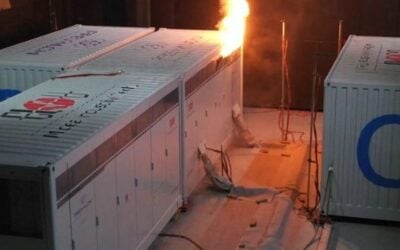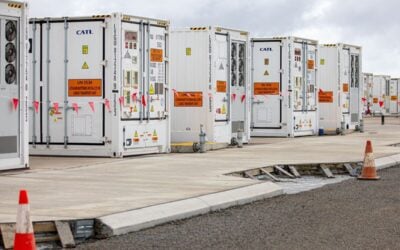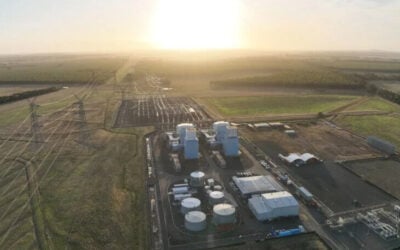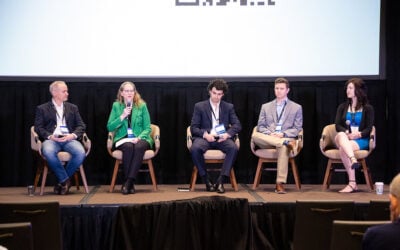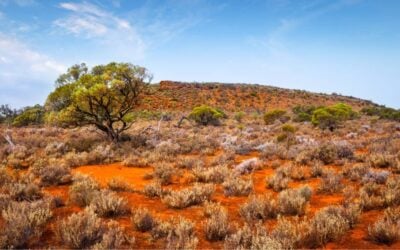
Suitable energy storage project sites are quickly being snapped up by developers in Australia’s National Electricity Market (NEM), with a premium on grid location.
A panel discussion on Day Two of Energy Storage Summit Australia 2025 centred on the real-world experiences of energy storage developers.
Enjoy 12 months of exclusive analysis
- Regular insight and analysis of the industry’s biggest developments
- In-depth interviews with the industry’s leading figures
- Annual digital subscription to the PV Tech Power journal
- Discounts on Solar Media’s portfolio of events, in-person and virtual
Or continue reading this article for free
“There’s been a real land grab for sites in the NEM and that is a challenge in itself,” said Killian Wentrup, head of development at Acen Australia.
“There’s been a kind of a gold rush of what we would loosely describe as front-end developers, large independent power producers (IPPs), mid-tier developers and everything in between, trying to secure sites close to substations along lines that can be economically cut in on for big projects,” Wentrup said.
Andy Tang, head of system integrator Wärtsilä ES&O, described Australia as a proving ground for some of the biggest gigawatt-hour-scale battery energy storage systems (BESS) and hybrid solar-plus-storage assets in the world in a recent interview with Energy-Storage.news.
That’s been a great news story for the role of energy storage in the country’s transition to renewable energy and for the stabilisation of its grid network which spans enormous distances. For developers, it creates new competitive pressures.
Grid location ‘really is everything’
“That really has resulted in an escalation of prices and terms and shootout rounds [in tenders] and all sorts of things,” Wentrup said, with his company among those developing standalone and hybrid BESS projects in the scale of hundreds of megawatts output and gigawatt-hour capacity.
Daphne Yao, CEO of Valent Energy, a joint venture (JV) between private equity fund Gaw Capital and global energy storage owner-operator BW ESS, said that “finding the optimum location is always a challenge for any developer.”
Valent Energy focuses exclusively on standalone battery storage assets, and in this space, Yao said, the business case is really built around big sites: “The bigger the better,” she said.
According to Tom Best, chief operating officer (COO) of Macquarie-backed developer Eku Energy, also focused on standalone assets, grid location “really is everything at the end of the day.”
Not only does a good location on the network enable faster connection—one of the major bottlenecks in Australia, which has perhaps the most stringent grid codes in the world—it also enables assets to have better access to revenue streams.
The NEM is Australia’s biggest interconnected wholesale and ancillary services market, spanning five states and territories in the South and East of the country.
As was heard from experts at the conference, including Wendel Hortop, Australia lead at market intelligence firm Modo Energy, revenues in the NEM are by no means uniform across the states and are highly dependent on localised factors, including grid congestion and renewable energy adoption.
Fast-track BESS permitting ‘would benefit Australia’s energy transition’
The construction and commissioning times of BESS and indeed, solar PV, are among the quickest compared to other energy resources like gas and nuclear, or even other clean resources like pumped hydro energy storage.
However, many steps must be taken before batteries can be put onto sites and put into commercial operation.
The panellists, prompted in the discussion by moderator Simon Mason of consultancy Everoze, broadly agreed that simplifying and speeding up permitting would benefit not just their businesses but also Australia’s consumers, for whom the addition of large-scale storage can bring down energy prices, aid decarbonisation, and enhance the security of electricity supply.
Killian Wentrup acknowledged that permitting BESS facilities can be quicker to implement in most Australian states than, say, wind, with Acen Energy having just gone through a three-year process to get a wind power plant in New South Wales (NSW) to approvals.
Even so, he said he hoped permitting for battery storage could become more streamlined and faster, expressing a view that governments and local councils “have really been playing catch up in the last few years to really understand the technology and understand the risks.”
“The rules are really being developed as we go through the development process, to be honest, and that’s a challenge as well,” Wentrup said.
Going back to the previous point around location, Valent Energy CEO Daphne Yao said developers “could be a bit more imaginative” about where they site their projects but also suggested that projects that offer the most benefit to the network could be prioritised for fast-track permits.
“I think this is where a lot of alignment around incentives and requirements can come together,” Yao said.
Batteries can play important roles in strengthening both transmission and distribution (T&D) networks. Yao, who has held previous roles working at network operator companies, said developers could be incentivised to site their BESS assets at strategic points where they provide the most system benefit.
Better valuation of batteries as a cheaper, quicker and effective non-wires alternative (NWA) to traditional investments in T&D infrastructure and fast-tracking them as such could be a way to solve the problem of long queues for grid connection and so-called “land banking at the very, very few remaining optimum sites,” Yao said.
Permitting battery storage is much quicker than permitting solar or wind, but there is “still a long way to go” in getting to where Australia needs to be to meet its clean energy targets, Yao said.
Community engagement means spending time, responding to concerns
Another side of the permitting coin is in making sure communities are comfortable with seeing battery storage facilities built in the locations that developers propose.
“Spending more time with landowners and communities is an important consideration. It’s not just about finding and securing the land and going through approvals,” Daphne Yao said.
“It’s up to us to up our game when it comes to community engagement and making sure that people really understand what these assets are, that we can debunk some of the myths around them, and that, in turn, will hopefully create a more supportive environment for us to develop what are pretty essential assets for our [energy] transition.”
While BESS fire incidents are rare and becoming more so proportionate to the sheer scale of global deployment, Eku Energy COO Tom Best said landowners are aware of some of the historical fires that have happened.
Best said that communities’ number one concern tends to be fire risk, although more recently some questions have been asked about noise, too.
Developers like Eku Energy are learning how to handle community concerns as the industry becomes more sophisticated, he said.
According to Best, five years ago, a BESS in a project Development Application (DA) in Australia “was a white box on a plan and a Capex assumption so that we could get it approved, and it was approved on that basis.”
“I think the industry has come a long way,” he said.
“We really understand what’s required from the planning perspective to gain approval. We’re doing preliminary assessments. We’re undertaking significant bushfire studies. We’re doing site fire studies and putting plans in place at the DA level.”
Similarly, leaning on lessons learned from the wind industry about noise to some extent, Eku Energy is dealing with noise pollution concerns “up front, putting in those walls where they’re needed.”
“The industry has responded to [community concerns] and as a whole, we’re able to respond to that questioning.”

